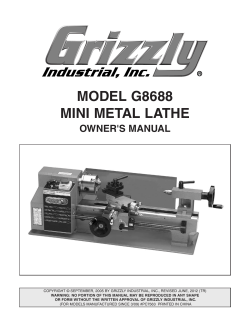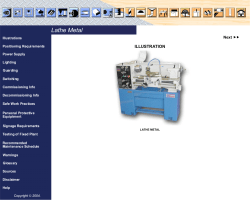
Lathe Work Holding Devices
Lathe Work Holding Devices Workpieces are held in lathe with the assistance of chucks, faceplates, or lathe centers. A lathe chuck is a device that exerts pressure on the workpiece to hold it secure to the headstock spindle or tailstock spindle. Commonly used with the lathe are the independent chuck (4 Jaw),the universal scroll chuck (3 Jaw), and the collet chuck. Independent Chuck - (4 Jaw) The independent chuck has four jaws which are adjusted individually on the chuck face by means of adjusting screws. The chuck face is scribed with concentric circles which are used for rough alignment of the jaws when chucking round workpieces. The final adjustment is made by turning the workpiece slowly and using dial indicators to determine its concentricity and to the desired tolerances. The jaws of the independent chuck may be used as in the figure shown, or may be reversed so that the steps face in the opposite direction; thus, workpieces can be gripped either externally or internally. The independent chuck can he used to hold square, round, octagonal, or irregular shaped workpieces in either a concentric or eccentric position due to theindependent operation of each jaw. Because of its versatility and capacity for fine adjustment, the independent chuck is commonly used for mounting workpieces that require extreme accuracy. Universal Scroll Chuck - (3 Jaw) The universal scroll chuck has three jaws which move in unison as an adjusting pinion is rotated. The advantage of the universal scroll chuck is its ease of operation in centering the work for concentric turning. This chuck is not as accurate as the independent chuck but, when in good condition, it will centre the work automatically within 0.003 of an inch of complete accuracy. The jaws are moved simultaneously within the chuck by means of a scroll or spiral threaded plate. The jaws are threaded to the plate and move an equal distance inward or outward as the scroll is rotated by means of the adjusting pinion. Since the jaws are individually aligned on the scroll, the jaws cannot be reversed. However, the chuck is usually supplied with two sets of jaws which can be interchanged. The universal scroll chuck can be used to hold and automatically centre round or hexagonal workpieces. Having only three jaws, the chuck cannot be used effectively to hold square, octagonal, or irregular shapes. Collet Chuck The collet chuck is the most accurate means of holding small workpieces in the lathe. The collet chuck consists of a spring machine collet and a collet attachment which secures and regulates the collet on the headstock spindle of the lathe. The spring machine collet is a thin metal bushing with an accurately machined bore and a tapered exterior. The collet has three lengthwise slots to permit its sides to be sprung slightly inward to grip the workpiece. To grip the workpiece accurately, the collet must be no more than 0.001 inch larger or smaller than the diameter of the piece to be chucked. For this reason, spring machine collets are generally supplied in sets with various capabilities in 1/16, 1/32, or 1/64 inch increments. For general purposes, the spring machine collets are limited in capacity to 1 inch in diameter. The collet attachment which, with the spring machine collet, forms the collet chuck and consists of a collet sleeve, a draw bar, and a handwheel or hand lever to move the draw bar. The collet is fitted to the right end of the headstock spindle. The draw bar passes through the headstock spindle and is threaded to the spring machine collet. When the draw bar is rotated by means of the handwheel, the collet is pulled inward and the collet walls are cammed together by contact with the collet sleeve, tightening the chuck to the workpiece. Collet chucks are usually standard equipment on toolroom-type engine lathes and on horizontal turret lathes. Spring machine collets are available in different shapes in order to chuck square and hexagonal workpieces of small dimensions as well as round workpieces. Jacobs Rubber-Flex Collets. The rubber flex collet is comprised of hardened alloy steel jaws bonded together with oil-resistant Hycar synthetic rubber. The collets have a range of 1/8 inch per collet and the gripping power and accuracy remain constant throughout the entire collet capacity. These collets are designed for heavy-duty turning and possess 2 to 4 times the grip of conventional split steel type collets.
© Copyright 2025

















